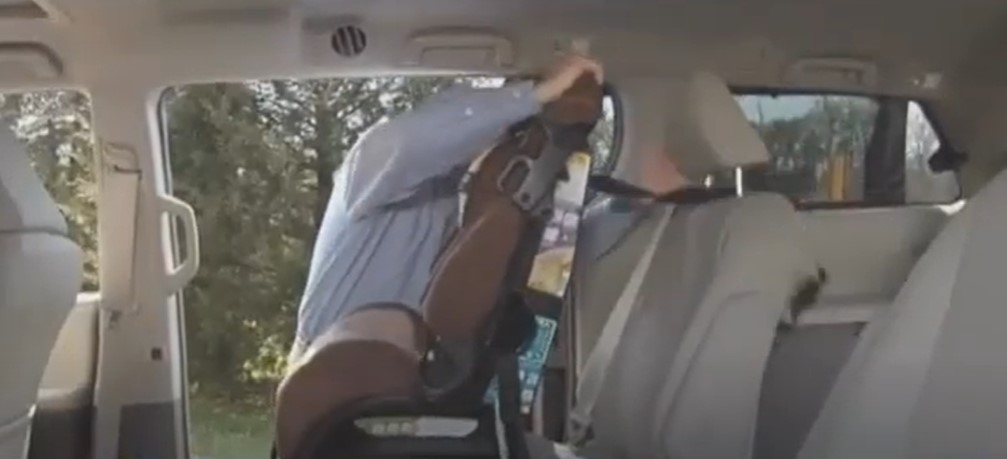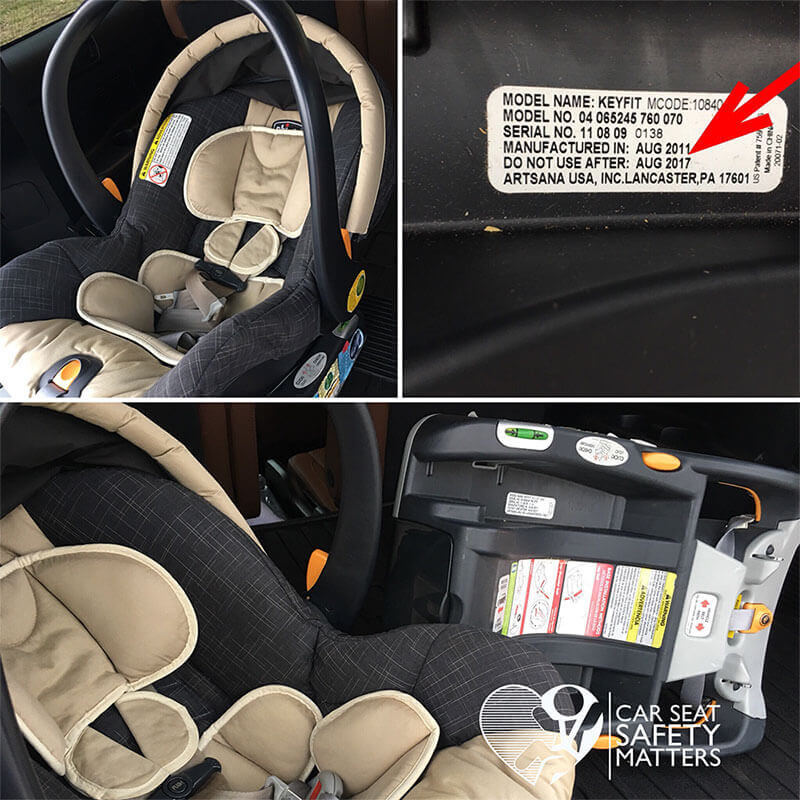Car seats have expiration dates because the materials they are made of degrade over time. The plastic and foam in car seats can deteriorate, making them less effective at protecting passengers in a crash. The straps and other parts can also wear out, making the seat less safe.
Your car seat has an expiration date for a reason. Just like any other safety device in your vehicle, it needs to be replaced after a certain amount of time. The materials and construction of your car seat can break down over time, which could lead to a dangerous situation if you were ever in an accident.
So why does my car seat have an expiration date? It’s simple – to keep you and your family safe. Make sure to check the expiration date on your car seat and replace it when necessary.
It could mean the difference between life and death.

Is a Car Seat Still Good After Expiration Date?
Most car seats have an expiration date of around six years from the date of manufacture. However, this doesn’t mean that the seat is no longer safe to use after that point.
The expiration date is simply a guideline put in place by the manufacturer to ensure optimal safety for your child.
That being said, it’s always best to err on the side of caution and replace your car seat before it expires. If you can’t afford to do so, make sure to inspect the seat thoroughly for any signs of wear and tear before each use.
Additionally, keep in mind that car seats are not designed to last forever; eventually, they will need to be replaced regardless of their expiration date.

Why Does My Car Seat Have an Expiration Date?
Car seats have an expiration date for a number of reasons, including:
- Wear and tear: Car seats are subject to a lot of wear and tear, especially if they are used frequently. Over time, the materials in the car seat can break down and weaken, making them less effective in protecting your child in a crash.
- Exposure to the elements: Car seats are often exposed to extreme temperatures, sunlight, and other elements. This exposure can also damage the materials in the car seat over time.
- Changes in safety standards: Safety standards for car seats are constantly changing. Newer car seats are designed to meet the latest safety standards, and older car seats may not meet these standards.
For all of these reasons, it is important to replace your car seat after a certain period of time. Most car seats have an expiration date of 6–10 years from the date of manufacture. However, it is always best to check the expiration date on your car seat to be sure.
Here are some additional tips for keeping your car seat safe:
- Inspect your car seat regularly for any signs of damage, such as cracks, tears, or loose parts.
- Replace the car seat if it has been in a car accident, even if it does not look damaged.
- Make sure the car seat is properly installed in your vehicle each time you use it.
If you have any questions about the safety or expiration date of your car seat, you can contact the manufacturer or a certified child passenger safety technician.
Where is the expiration date on a car seat?
The expiration date on a car seat is usually printed on the bottom of the seat or on the frame. It may be a sticker or a stamped date. Some manufacturers also include the expiration date in the car seat’s manual.
If you can’t find the expiration date on your car seat, you can contact the manufacturer for more information.
Here are some tips for finding the expiration date on a car seat:
- Look under the seat or on the frame. The expiration date is often printed on a sticker or stamped into the plastic.
- Check the car seat’s manual. The expiration date may be listed in the manual, along with other important safety information.
- Contact the manufacturer. If you can’t find the expiration date on your car seat, you can contact the manufacturer for more information.

How Long Does Infant Car Seat Last?
An infant car seat typically lasts for about one year, though it can vary depending on the brand and model. After that, you’ll need to upgrade to a convertible car seat or a booster seat.

How long are booster seats good for?
Booster seats are typically good for 6-10 years, depending on the manufacturer and the specific model. However, it is important to check the expiration date on your booster seat, which is usually printed on the bottom of the seat or on the frame.
Do not use a booster seat past its expiration date, even if it looks like it is in good condition.
There are a few reasons why booster seats have an expiration date. First, the materials used in booster seats can degrade over time, making them less safe. Second, booster seats are subject to wear and tear, which can also weaken them.
Finally, safety standards for booster seats change over time, and older seats may not meet the latest standards.
In addition to checking the expiration date, there are a few other things you can do to make sure your booster seat is safe:
- Inspect the booster seat regularly for any signs of damage, such as cracks, tears, or loose parts.
- Replace the booster seat if it has been in a car accident, even if it does not look damaged.
- Make sure the booster seat is properly installed in your vehicle each time you use it.
If you have any questions about the safety or expiration date of your booster seat, you can contact the manufacturer or a certified child passenger safety technician.

Here are some tips for choosing a booster seat:
- Choose a booster seat that is appropriate for your child’s weight and height.
- Make sure the booster seat has a high back and a wide seat base.
- Choose a booster seat that is easy to install and use.
- Read the manufacturer’s instructions carefully before using the booster seat.
Here are some tips for using a booster seat safely:
- Always make sure your child is properly buckled into the booster seat.
- Position the booster seat in the center of the rear seat.
- Never use a booster seat in the front seat of a vehicle with an active passenger air bag.
- Make sure the shoulder belt fits snugly across your child’s chest, not their neck.
By following these tips, you can help keep your child safe in the car.
Is It Illegal to Use an Expired Car Seat?
When it comes to car seats, expiration dates are serious business. Most car seats expire after six years from the date of manufacture, though there are a few that last up to 10 years. The reason for this is that over time, car seats can degrade and become less safe.
The materials they’re made of can break down, and the hardware can become corroded or damaged. So what does this mean for you? If you have an expired car seat, it’s best to replace it with a new one.
However, we understand that not everyone can afford to do this on a regular basis. If you must use an expired seat, make sure to inspect it thoroughly before each use. Check all the straps and buckles to make sure they’re in good condition and not frayed or damaged in any way.
Also, look at the shell of the seat; if there are any cracks or signs of wear and tear, it’s best to find a different seat. If you have any questions about whether your car seat is safe to use, don’t hesitate to contact the manufacturer or your local police department for guidance. It’s better to be safe than sorry when it comes to your child’s safety!
Do Booster Seats Have Expiration Dates?
Do booster seats expire? The answer is yes. And as a parent, you should do everything you can to keep your child safe. That includes making sure they’re properly secured in a booster seat when riding in the car. But did you know that those booster seats have expiration dates?
It’s important to be aware of this so that you can replace an expired seat before it becomes unsafe. Here’s what you need to know about the expiration dates on booster seats. Most manufacturers design their seats to last for around six years.
However, the materials used in the seats can break down over time from exposure to sunlight and other elements. Additionally, the straps and other parts of the seat can become worn from use. For these reasons, it’s important to check your child’s booster seat regularly for signs of wear and tear.
If any parts look worn or damaged, it’s time to replace the seat. Even if the seat hasn’t reached its expiration date yet, it’s not worth taking chances with your child’s safety. If you’re not sure when your child’s booster seat was manufactured, you can usually find this information on a label somewhere on the seat.
Once you know the date, make a note of it so that you can keep track of how long it’s been in use. And be sure to inspect the seat regularly for any damage or wear and tear. Replacing an expired or damaged booster seat is essential for keeping your child safe while riding in the car.
Don’t wait until it’s too late; check your seats today and be sure they’re still in good condition!

When Do Graco Car Seats Expire?
Most car seats have an expiration date of about six years from the date of manufacture. The Graco 4Ever, for example, expires after September 2023. However, it’s important to note that these expiration dates are not set in stone and may vary depending on the model and manufacturer.
It’s always best to check your car seat’s manual for specific information.
The main reason car seats expire is because the materials they’re made of break down over time. The plastic and metal components can become brittle and weak, which could lead to them breaking during a crash.
In addition, the padding in car seats can compress and deteriorate over time, making them less effective at protecting your child in a collision.
That said, just because your car seat has expired doesn’t mean it’s automatically unsafe. If you’re still using it and it hasn’t been involved in a crash, chances are it’s still fine to use.
However, if you have any doubts whatsoever, it’s always best to err on the side of caution and get a new one. It’s not worth risking your child’s safety!
Safety First Car Seat Expiration
Most car seats have an expiration date. The materials in the seat can break down over time and may not provide the same level of protection in a crash. Check your car seat’s expiration date and replace it if necessary.
If you’re not sure when your car seat expires, look for the manufacturer’s label. It should be located on the back of the seat or on a sticker under the seat. The expiration date will be listed as a month and year.
For example, “EXP 12/2020” means that the car seat expires in December 2020. Some car seats don’t have an expiration date, but they still need to be replaced after a certain amount of time. These seats usually have a warning label that says something like “This car seat is good for 6 years.”
This means that you should replace the seat after 6 years, even if it hasn’t been involved in a crash. If you’re not sure whether your car seat has expired or not, contact the manufacturer for more information.
Britax Car Seat Expiration
Most car seats have an expiration date of around six years from the date of manufacture. The reason for this is that over time, car seats can degrade and become less safe. The materials in the seat can break down, and the straps and other parts can become worn or damaged.
If you have a Britax car seat, you can find the expiration date on a sticker on the back of the seat. If your seat has expired, it’s important to replace it with a new one as soon as possible. Don’t try to use an expired seat – it could be unsafe for your child.

Joie Car Seat Expiry Date
If you have a Joie car seat, it’s important to know when the expiry date is. The expiration date can be found on a sticker on the bottom of the car seat. It’s important to note that the expiry date is different from the “born on” date, which is the date that the car seat was manufactured.
The born-on date can be found on a label on the back of the car seat. The expiration date for Joie car seats is typically 10 years from the date of birth. However, it’s important to check your specific car seat’s expiration date, as some models may have different expiration dates.
If you’re not sure when your car seat expires, you can contact Joie customer service for assistance. It’s important to replace your child’s car seat before it expires. An expired car seat may not provide adequate protection in an accident and could put your child at risk.
If you have an expired Joie car seat, you can contact Joie customer service to arrange for a replacement.

Chicco Car Seat Expiration
When it comes to car safety, one of the most important things to consider is the expiration date on your child’s car seat. Many parents don’t realize that car seats have expiration dates, but it’s something you should definitely be aware of. The Chicco car seat is a popular choice for many families, so let’s take a look at when these seats expire.
The first thing to know is that there are two different types of Chicco car seats- those with an aluminum frame and those without. The seats with an aluminum frame have a lifespan of 6 years, while the non-framed seats expire after 10 years. That means that if your child’s Chicco seat was manufactured in 2013 or later, it will need to be replaced in 2019.
If you’re not sure when your seat was manufactured, you can find this information on a sticker located on the back of the seat. It’s important to note that even if your Chicco seat hasn’t reached its expiration date, you may still need to replace it sooner if it has been in a car accident or shows signs of wear and tear.
If you have any questions about whether or not your seat needs to be replaced, consult with a certified child passenger safety technician.

Do Backless Booster Seats expire?
If you have a backless booster seat, you may be wondering if it has an expiration date. The answer is yes! Backless booster seats do expire, and it’s important to know when yours expires so you can replace it as needed.
The expiration date of your backless booster seat can be found on the label, which is typically located on the bottom or back of the seat. It’s important to note that just because a backless booster seat doesn’t have an expiration date listed, that doesn’t mean it doesn’t expire.
Any backless booster seat that was manufactured before January 1, 2016, is considered expired and needs to be replaced.
If you’re not sure when your backless booster seat expires, or if you don’t see an expiration date listed, contact the manufacturer for more information.
Once you know when your backless booster seat expires, make sure to mark the date in your calendar so you can replace it as needed. And always remember to keep your child safe while riding in the car!
Car seats come with expiration dates
Conclusion
Most car seats have an expiration date of six years from the date of manufacture. The plastic and other materials in the seat can break down over time, making it less safe to use. If you’re not sure when your car seat was made, check the label on the back or bottom of the seat.
